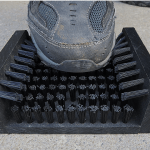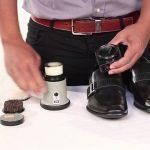Last weekend, I was visiting my friend’s farm with my kids. We spend the entire two days helping them out on the field and having a lot of fun. However, the amount of dirt, manure, and other cruds that our boots picked up was insane. We learned how to clean farm boots in order to protect the farm. Shoes and boots with dirt provide a perfect home for the bacteria that came along with them.

Why should you clean farm boots?
The number of disease-causing bacteria accumulating on farm boots over time is unimaginable, and the odor only worsens. The fact that the shoes go from the chicken house to the barn and then to the home means bacteria easily get from the coop to the table.
The top panel of the below image shows the soles of shoes with two different tread patterns after three steps: dirty, washed with water, and disinfected. The bottom panel of the image illustrates the organisms that grow from samples taken at each step. Acknowledgment: reproduced with the permission of CID LINES.

It is, therefore, very important to keep farm footwear clean to maintain biosecurity around the farm. A simple way to limit exposure to these bacteria is to ensure that visitors and staff accessing the farm thoroughly clean, wash and disinfect their boots.
How Do You Clean Farm Boots?
You can clean farm boots using this simple 3 steps process:
1. Remove the bulk of the mud and manure from the shoes using a boot scraper and then a pressure washer.
2. Step into a disinfectant bath and sit in it for at least 5 minutes with your boots on.
3. Regularly use some type of disinfectant to clean out the interior of the boots.
How Do You Remove Mud and Debris from Boots?
1. Clean Farm Boots with a brush or a scraper brush
To achieve thorough cleaning and disinfection, boots should be cleaned properly from the outside and inside. The dirt and debris should be removed, the outside of the boot should be disinfected, and the inside should be cleaned.
Organic material decreases the effectiveness of disinfectants. Therefore, the first thing to do is to remove the visible contamination from the boots. These contaminations include mud, dirt, debris, and manure.
You can use a mud scraper to remove the larger pieces of dirt and debris from the boot. Mud scraper brushes are outdoor tools with an upright metal base and brushes on either side. I have written an article about the best boot scrapers on the market today.
2. Wash your farm boots
For the remaining more resistant contaminants, use a boot brush and water hose for cleaning. You can use a boot brush alone, but using it with a water hose or bucket is highly recommended. Or you could use a pressure washer to complete the entire process faster.
You can establish a modified bucket filling station with proper drainage where you can step in, hose your boots and scrub them with a boot brush to get the dirt off. Alternatively, you can set up a boot-cleaning station with a hose attached to a brush for the same effect. Since these efforts are directed towards more resistant contaminants, it may take some time for it to loosen and come off.
3. Disinfect your farm boots
It is recommended to do this at the end of each day. Once the mud and dirt are correct of, the next step is disinfecting the boots.
How Do You Disinfect Farm Boots?
To disinfect the boots, you should soak them in a clean disinfectant solution. Allow proper surface contact between the disinfectant and the boot. Ensure the boots are submerged in the disinfectant at least 2 inches above the highest point that the mud reached before you hosed it off.
Disinfectants do not act instantaneously. You cannot step in and step out immediately. These disinfectant solutions require time to work correctly. For most of them, action time is provided on the label – it can vary from 10 to 20 minutes depending on the concentration of the solution.
You should opt for a disinfectant that is effective across a wide spectrum of bacteria and germs as farms offer a variety of them. To ensure maximum efficiency, take other precautions such as checking the water’s pH as hard water deactivates some disinfectants, use recommended water temperature for dilution and know the disinfectant’s effective period as some lose activity quickly after dilution.
How Do You Remove Bad Odors from Boots?
The outer surface of the boots is a logical residence for bacteria and germs, but it is not the only place they are found. They are present inside the boot as well. You probably have noticed that when you take off your boot, there is a foul odor.
I experienced it just after my two days at the farm. The odor is caused by the fact that the boots are completely waterproof and they get very sweaty and hot: perfect breeding ground for bacteria. Therefore proper cleaning of boots means the elimination of these bacteria from inside as well.
There are a few techniques that you can apply using readily available household items. You can take a piece of muslin cloth and fashion it into a pouch. Use soda bicarbonate with few drops of Tea Tree Essential Oil as filling for the pouch. You can place the pouch inside the shoe.
Alternatively, you can skip the pouch part, sprinkle the mixture inside the boot, and vacuum it out later. In either case, leave it overnight or at least for a few hours. The bicarbonate will absorb any smell while the tea tree oil will eliminate the bacteria and germs. And you will be left with boots that are clean, germ-free and odorless.
How to disinfect and clean farm boots on a farm (video)
Related Shoe cleaning Guides
- Best Suede Shoe Protector
- Best Shoe Stretcher Spray
- Best Shoe Horn
- Best Suede Eraser
- How to Keep Shoes From Dry Rotting?
- Best Shoe Stretcher for Bunions
- Best Suede Shoe Brush
- How to Stop Shoes from Squeaking with 7 simple tricks
- Best Shoe Trees
- Best Saddle Soap
- Best Wax Shoe Polish: how to revive your shoes?
- Best Liquid Shoe Polish: Does liquid polish work?
- Best Boot Scraper Brush : What are they for & where placed best?
- Best Boot Scraper
- Best Edge Dressing
- Best Nubuck Cleaners
- Best Shoe Shine Sponge
- How Do You Clean Farm Boots?
- Best Electric Shoe Polisher
- What Is a Shoe Mitt and How to Use It
- Can You Dry Shoes with a Blow Dryer? Yes, with Tips & alternatives






















